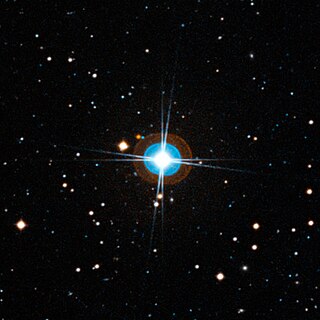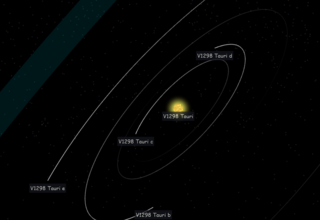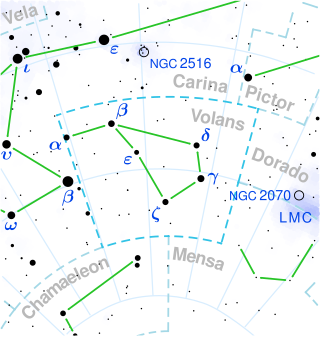Pi Mensae, also known as HD 39091, is a G-dwarf star in the constellation of Mensa. This star has a high proper motion. The apparent magnitude is 5.67, which can be visible to the naked eye in exceptionally dark, clear skies. It is nearly 60 light-years away. The star is slightly larger than the Sun in terms of mass, size, luminosity, temperature and metallicity, and is about 730 million years younger. It hosts three known planets.
This page describes exoplanet orbital and physical parameters.
HD 13931 is a Sun-like star in the northern constellation of Andromeda. It can be viewed with binoculars or a small telescope but is too faint to be seen with the naked eye, having an apparent visual magnitude of 7.60. This object is located at a distance of 154 light years from the Sun, as determined from its parallax, and is drifting further away with a radial velocity of +31 km/s.

HD 10180, also designated 2MASS J01375356-6030414, is a Sun-like star in the southern constellation Hydrus that is notable for its large planetary system. Since its discovery, at least six exoplanets have been observed orbiting it, and some studies have proposed up to nine potential planets, which would make it potentially the largest of all known planetary systems, including the Solar System.
ADS 7251 is a binary star system 6.33 parsecs from the Sun. The components are near-identical red dwarfs separated by 17″ in 2019.
HD 96700 is the Henry Draper Catalogue designation for a star in the equatorial constellation of Hydra. It has an apparent visual magnitude of 6.51, which puts it below the limit that can be seen with the naked eye by a typical observer. Based upon parallax measurements, this star is around 83 light years away from the Sun. It is drifting further away with a radial velocity of 12.8 km/s.
HD 3167 is a single, orange-hued star in the zodiac constellation of Pisces that hosts a system with three exoplanets. The star is too faint to be seen with the naked eye, having an apparent visual magnitude of 8.97. The distance to HD 3167 can be determined from its annual parallax shift of 21.1363 mas as measured by the Gaia space observatory, yielding a range of 154 light years. It has a relatively high proper motion, traversing the celestial sphere at the rate of 0.204″ per year. Since it was first photographed during the Palomar observatory sky survey in 1953, it had moved over 12.5″ by 2017. The star is moving away from the Earth with an average heliocentric radial velocity of +19.5 km/s.

HD 21749 is an orange main-sequence star in the constellation Reticulum. It has an apparent visual magnitude of 8.143, which means it is too dim to be seen with the naked eye. From parallax measurements by the Gaia spacecraft, it is located 53 ly (16 pc) from Earth.

HR 858 is a star with a planetary system located 103 light-years from the Sun in the southern constellation of Fornax. It has a yellow-white hue and is visible to the naked eye, but it is a challenge to see with an apparent visual magnitude of 6.4. The star is drifting further away with a radial velocity of 10 km/s. It has an absolute magnitude of +3.82.

V1298 Tauri is a young weakly-lined T Tauri star that is part of the Taurus-Auriga association in the Taurus Molecular Cloud. Alternatively it is part of a proposed moving group, called Group 29 that is slightly older. The system has four transiting exoplanets, discovered with the Kepler space telescope in the K2 mission. One of the planets was discovered in August 2019 and the other three were discovered in November 2019 by the same team.
HD 4313 is a star with an orbiting exoplanetary companion in the constellation of Pisces. It has an apparent visual magnitude of 7.83, which is too faint to be reading visible to the unaided eye. The systam is located at a distance of 446 light years based on parallax, and is drifting further away with a radial velocity of 14.5 km/s. This is a single star, which means it has no binary partners, at least in range of projected separations from 6.85 to 191.78 AU. It hosts an extrasolar planet.
HD 77338 is a star with a close orbiting exoplanet companion in the southern constellation of Pyxis. It is too dim to be visible with the naked eye, having an apparent visual magnitude of 8.63. The system is located at a distance of 149 light years, and it is drifting further away with a heliocentric radial velocity of 8.2 km/s.
Kepler-410 is a binary star system. Its primary star, also known as Kepler-410A, is a F-type subgiant star, orbited by the orange dwarf star Kepler-410B on a wide orbit. The companion star was discovered in 2012.
TOI-4342 is a red dwarf star in the constellation Octans located 201 light-years from Earth. It hosts two transiting exoplanets. Both planets are considered to be good targets for transmission spectroscopy measurements for determination of atmospheric composition.
TOI-813 is a bright subgiant G-type star located 858 light-years away from planet Earth. It is too faint to be seen with the naked eye. TOI-813 has a mass of 1.32 solar masses, a radius of 1.95 solar radii and a luminosity of 4.3 times the solar luminosity.

HD 76920 is a solitary orange-hued star with an orbiting exoplanetary companion in the southern constellation of Volans, close to the border with Carina. With an apparent magnitude of 7.82, it is too faint to be seen by the naked eye from Earth but is readily observable through binoculars. It is located at a distance of 597 light-years according to Gaia EDR3 parallax measurements, and is moving away at a heliocentric radial velocity of 20.09 km/s.
HD 73344 is a star located in the constellation Cancer. It has a faint apparent magnitude of 6.9 and therefore can't be seen by the naked eye. It is located 35.2 parsecs away based on parallax measurements. This star hosts three confirmed exoplanets.

HD 147379 is a wide visual binary between two red dwarfs in the deep northern constellation of Draco. The two stars are located approximately 35.1 light-years (10.8 pc) distant based on Gaia EDR3 parallax measurements, and approaching the Solar System at heliocentric radial velocities of −18.962 km/s and −18.36 km/s, respectively. The brighter primary star, HD 147379A, has an apparent magnitude of 8.9, too faint to be seen by the naked eye from Earth but visible using binoculars. The dimmer secondary, B, fluctuates in apparent magnitude between 10.69 and 10.74, making it observable via a telescope with an aperture of 35 mm or larger.






